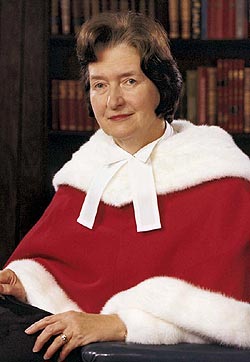The urban survival syndrome, in United States jurisprudence, can be used either as a defense of justification or of excuse. The first case using, unsuccessfully, the defense of "urban survival syndrome" is the 1994 Fort Worth, Texas murder trial of Daimion Osby.

R v Morgentaler, [1988] 1 SCR 30 was a decision of the Supreme Court of Canada which held that the abortion provision in the Criminal Code was unconstitutional because it violated women's rights under section 7 of the Canadian Charter of Rights and Freedoms ("Charter") to security of the person. Since this ruling, there have been no criminal laws regulating abortion in Canada.
Claire L'Heureux-Dubé is a retired Canadian judge who served as a puisne justice on the Supreme Court of Canada from 1987 to 2002. She was the first woman from Quebec and the second woman appointed to this position, after Bertha Wilson. Previously, she had been one of the first woman lawyers to handle divorce cases, and was the first woman appointed as a judge to the Quebec Superior Court and the Quebec Court of Appeal.

Bertha Wernham Wilson was a Canadian jurist and the first female puisne justice of the Supreme Court of Canada. Before her ascension to Canada's highest court, she was the first female associate and partner at Osler, Hoskin & Harcourt and the first woman appointed to the Court of Appeal for Ontario. During her time at Osler, she created the first in-firm research department in the Canadian legal industry.
Battered woman syndrome (BWS) is a pattern of signs and symptoms displayed by a woman who has suffered persistent intimate partner violence—psychological, physical, or sexual—from her male partner. It is classified in the ICD-9 as battered person syndrome, but is not in the DSM-5. It may be diagnosed as a subcategory of post-traumatic stress disorder (PTSD). Victims may exhibit a range of behaviors, including self-isolation, suicidal thoughts, and substance abuse, and signs of physical injury or illness, such as bruises, broken bones, or chronic fatigue.

Delgamuukw v British Columbia, [1997] 3 SCR 1010, also known as Delgamuukw v The Queen, Delgamuukw-Gisday’wa, or simply Delgamuukw, is a ruling by the Supreme Court of Canada that contains its first comprehensive account of Aboriginal title in Canada. The Gitxsan and Wet’suwet’en peoples claimed Aboriginal title and jurisdiction over 58,000 square kilometers in northwest British Columbia. The plaintiffs lost the case at trial, but the Supreme Court of Canada allowed the appeal in part and ordered a new trial because of deficiencies relating to the pleadings and treatment of evidence. In this decision, the Court went on to describe the "nature and scope" of the protection given to Aboriginal title under section 35 of the Constitution Act, 1982, defined how a claimant can prove Aboriginal title, and clarified how the justification test from R v Sparrow applies when Aboriginal title is infringed. The decision is also important for its treatment of oral testimony as evidence of historic occupation.

William Ian Corneil Binnie is a former puisne justice of the Supreme Court of Canada, serving from January 8, 1998 to October 27, 2011. Of the justices appointed to the Supreme Court in recent years, he is one of the few appointed directly from private practice. On his retirement from the Court, he was described by The Globe and Mail as "arguably the country's premier judge", by La Presse as "probably the most influential judge in Canada of the last decade" and by the Toronto Star as “one of the strongest hands on the court.”
Section 11 of the Canadian Charter of Rights and Freedoms is the section of the Canadian Constitution that protects a person's legal rights in criminal and penal matters. There are nine enumerated rights protected in section 11.

R v Béland [1987] 2 S.C.R. 398 is a leading Supreme Court of Canada decision where the Court rejected the use of polygraph results as evidence in court.
In English law, provocation was a mitigatory defence to murder which had taken many guises over generations many of which had been strongly disapproved and modified. In closing decades, in widely upheld form, it amounted to proving a reasonable total loss of control as a response to another's objectively provocative conduct sufficient to convert what would otherwise have been murder into manslaughter. It only applied to murder. It was abolished on 4 October 2010 by section 56(1) of the Coroners and Justice Act 2009, but thereby replaced by the superseding—and more precisely worded—loss of control defence.

Pappajohn v R, [1980] 2 S.C.R. 120 is a famous Supreme Court of Canada decision on the criminal defence of mistake of fact.

Lewis v R, [1979] 2 S.C.R. 821 is a famous decision of the Supreme Court of Canada on the relevance of motive in a criminal trial. The Court held that motive is never an essential element of a criminal offence but can be used as evidence to prove intent.

R v Mohan, 1994 CanLII 80, [1994] 2 SCR 9 is a leading Supreme Court of Canada decision on the use of expert witnesses in trial testimony.

R v Stevens, [1988] 1 S.C.R. 1153, was a decision of the Supreme Court of Canada rendered on June 30, 1988, concerning the retrospective application of the Canadian Charter of Rights and Freedoms.

Azoulay v R, [1952] 2 S.C.R. 495 was a decision by the Supreme Court of Canada on abortion in Canada. The court found that with evidence so complicated, a judge should summarize it to a jury.

R v Marquard, [1993] 4 S.C.R. 223, is a leading case of the Supreme Court of Canada on the admissibility of expert testimony.

R v W (D), [1991] 1 S.C.R. 742 is a leading decision of the Supreme Court of Canada on assessing guilt based on the credibility of witnesses in a criminal trial. More specifically, W.D. examines sexual assault cases and burdens of proof in evidence law.

R v Coote is a Canadian constitutional law decision in 1873 dealing with the powers of the provinces under the British North America Act, 1867. The point in issue was whether Quebec had the constitutional authority to create a mandatory inquiry power for provincial fire commissioners.

R v Henry [2005] 3 S.C.R. 609 is a leading Supreme Court of Canada case on the protection against self-incrimination in section 13 of the Canadian Charter of Rights and Freedoms. The court ruled that the Crown may use the accused's previous voluntarily given testimony to incriminate or impeach credibility in a retrial if the accused again chooses to testify at said retrial. The court further held that no distinction should be drawn between the use of such evidence to incriminate the accused directly or to impeach their credibility. The Court partially restored this distinction in R. v. Nedelcu, 2012 SCC 59.
Richard Jamieson Scott was a Canadian jurist who served as Chief Justice of Manitoba. In that capacity, he presided over the Manitoba Court of Appeal from 1990 to 2013. Among his most notable decisions are those in the cases Rebenchuk v Rebenchuk (2007), Manitoba Métis Federation Inc v Canada et al. (2010), O'Brien v Tyrone Enterprises Ltd (2012), and, while he was on the Court of Queen's Bench of Manitoba, R v Lavallee.




